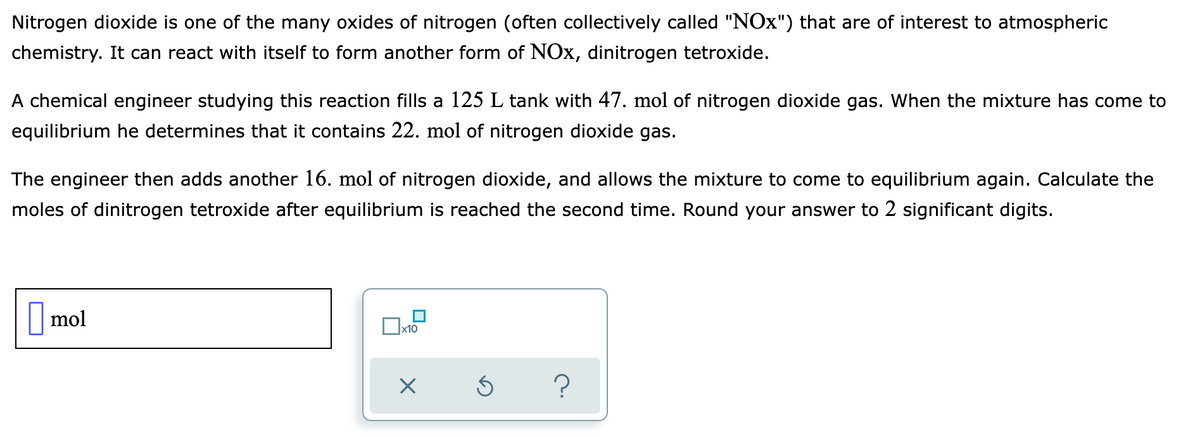Nitrogen dioxide is one of the many oxides of nitrogen (often collectively called "NOx") that are of interest to atmospheric chemistry. It can react with itself to form another form of NOx, dinitrogen tetroxide. A chemical engineer studying this reaction fills a 125 L tank with 47. mol of nitrogen dioxide gas. When the mixture has come to equilibrium he determines that it contains 22. mol of nitrogen dioxide gas. The engineer then adds another 16. mol of nitrogen dioxide, and allows the mixture to come to equilibrium again. Calculate the moles of dinitrogen tetroxide after equilibrium is reached the second time. Round your answer to 2 significant digits. |mol
Nitrogen dioxide is one of the many oxides of nitrogen (often collectively called "NOx") that are of interest to atmospheric chemistry. It can react with itself to form another form of NOx, dinitrogen tetroxide. A chemical engineer studying this reaction fills a 125 L tank with 47. mol of nitrogen dioxide gas. When the mixture has come to equilibrium he determines that it contains 22. mol of nitrogen dioxide gas. The engineer then adds another 16. mol of nitrogen dioxide, and allows the mixture to come to equilibrium again. Calculate the moles of dinitrogen tetroxide after equilibrium is reached the second time. Round your answer to 2 significant digits. |mol
Chemistry
10th Edition
ISBN:9781305957404
Author:Steven S. Zumdahl, Susan A. Zumdahl, Donald J. DeCoste
Publisher:Steven S. Zumdahl, Susan A. Zumdahl, Donald J. DeCoste
Chapter13: Chemical Equilibrium
Section: Chapter Questions
Problem 129MP: A gaseous material XY(g) dissociates to some extent to produce X(g) and Y(g): XY(g)X(g)+Y(g) A...
Related questions
Question

Transcribed Image Text:Nitrogen dioxide is one of the many oxides of nitrogen (often collectively called "NOx") that are of interest to atmospheric
chemistry. It can react with itself to form another form of NOx, dinitrogen tetroxide.
A chemical engineer studying this reaction fills a 125 L tank with 47. mol of nitrogen dioxide gas. When the mixture has come to
equilibrium he determines that it contains 22. mol of nitrogen dioxide gas.
The engineer then adds another 16. mol of nitrogen dioxide, and allows the mixture to come to equilibrium again. Calculate the
moles of dinitrogen tetroxide after equilibrium is reached the second time. Round your answer to 2 significant digits.
||mol
x10
Expert Solution
This question has been solved!
Explore an expertly crafted, step-by-step solution for a thorough understanding of key concepts.
Step by step
Solved in 3 steps

Knowledge Booster
Learn more about
Need a deep-dive on the concept behind this application? Look no further. Learn more about this topic, chemistry and related others by exploring similar questions and additional content below.Recommended textbooks for you

Chemistry
Chemistry
ISBN:
9781305957404
Author:
Steven S. Zumdahl, Susan A. Zumdahl, Donald J. DeCoste
Publisher:
Cengage Learning


Chemistry: An Atoms First Approach
Chemistry
ISBN:
9781305079243
Author:
Steven S. Zumdahl, Susan A. Zumdahl
Publisher:
Cengage Learning

Chemistry
Chemistry
ISBN:
9781305957404
Author:
Steven S. Zumdahl, Susan A. Zumdahl, Donald J. DeCoste
Publisher:
Cengage Learning


Chemistry: An Atoms First Approach
Chemistry
ISBN:
9781305079243
Author:
Steven S. Zumdahl, Susan A. Zumdahl
Publisher:
Cengage Learning

Principles of Modern Chemistry
Chemistry
ISBN:
9781305079113
Author:
David W. Oxtoby, H. Pat Gillis, Laurie J. Butler
Publisher:
Cengage Learning

Introductory Chemistry: A Foundation
Chemistry
ISBN:
9781337399425
Author:
Steven S. Zumdahl, Donald J. DeCoste
Publisher:
Cengage Learning

Chemistry: Principles and Practice
Chemistry
ISBN:
9780534420123
Author:
Daniel L. Reger, Scott R. Goode, David W. Ball, Edward Mercer
Publisher:
Cengage Learning